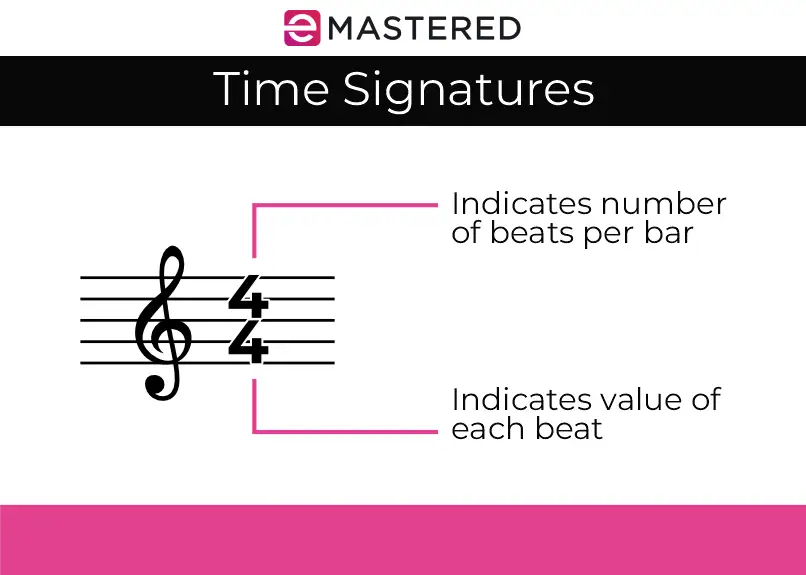Part of your job as a musician is to keep a listener's interest reflecting the mood and themes of any given song or piece. While less common today, a powerful technique is to change time signatures within a piece or body of work. Shifting your time signature can create intriguing movement in your composition, and help emphasize the highlights of your piece - but how does one seamlessly move from one time signature to another?
Time signature changes may seem somewhat daunting, but they are much more approachable than they seem once you understand the basics. We'll explain the foundational steps behind changing time signatures below so that you can incorporate this technique into your pieces, regardless of whether you're a music theory aficionado.
What Is a Time Signature?
In music notation, the time signature indicates how to count and perform a piece of music rhythmically. It is comprised of two numbers like a fraction, with one number on top and the other directly below. The top number indicates the amount of beats per bar or measure, while the bottom number indicates what type of note is valued as one beat.
The most common time signature is 4/4, appropriately named "common time". According to this time signature, there are four beats per measure, with the quarter note counting as one beat.

The 4 Different Types of Time Signatures
There is a wide variety of time signatures, though some are more common than others. These are the four main subcategories you'll come across;
Simple Time Signatures
Simple time signatures include those that are easy to count, typically with a denominator that's easily divisible into two even parts. The most common time signature, 4/4 exemplifies this principle perfectly. Other simple time signatures include 2/4 and 3/4. In this case, the quarter note would act as one beat.
Compound Time Signatures
Compound time signatures have a numerator that is divisible into three parts. This includes time signatures like 6/8, 9/8, and 12/8 where the eighth note gets one whole beat. For instance, with a time signature like 3/8, three eighth notes would be notated per measure as shown by their note value.
Complex Time Signatures
These are arguably the most odd time signatures relative to simple time and compound time signatures. In these time signatures, the top number or numerator is not easily divisible by 2 or 3 as seen with simple and complex time. Complex time signatures include meters like 5/8, 5/4, and 7/8, for example.
Mixed Meter Time Signatures
A piece contains mixed meter time signatures when it has a combination of simple, compound, and complex time signatures. Technically, this isn't a separate type of time signature per se, but whenever you're changing time signatures, you're working in mixed meter.
While you'll find that most popular music of today holds the same time signature, there may be more songs than you think that shift time signatures over the course of a song, as explained by creator David Bennett:
When Would You Need To Change Time Signatures?
So why would you have the need to change time signatures in a piece, anyway? Here are a couple of scenarios that may lend themselves to a time signature change:
Creating Contrast
A time signature change naturally creates a sense of before and after. You can create extra tension between the chorus and verse of a song, for instance, with a time signature change.
Transitioning Between Pieces or Sections
This may be more common in classical music, but time signature changes can be an incredible tool for bridging the gap between movements or different sections of songs.
Reflecting the Mood of a Piece
Popular western music tends to be somewhat repetitive, so shifting time signature can signify a great change in pace or emotion. This technique is frequently used in film music composition, though it can be used to great effect in traditional composition, too.
Making Space
Changing time signatures can make space for additional lyrics, melodies, and more. It can also create needed tension between two sections of a piece.
What is Mixed Meter?
Mixed meter can be broken down into using multiple time signatures within one piece of music. This can happen in several different ways, with the following terms being an important part of that understanding:
Metric modulation
This term refers to a composition in which metric components are dramatically changed - this could be changes in time signature, tempo, accents, or note values. All time signature changes are metric modulations, but not all modulations are necessarily time signature changes.
Metrical shift
A metrical shift refers to a typically smaller metric change that is more or less isolated in a piece. For instance, maybe the last measure of the chorus is in a different time signature. These small changes might not alter the nature of the entire piece whereas a metric modulation may have a stronger effect.
Examples of Popular Songs in Mixed Meter
You can find plenty of unusual time signatures (by today's standards) and mixed meter in compositions of the past. However, take a listen to these fairly modern pieces that may surprise you with their shifting meters:
Bohemian Rhapsody by Queen
Queen's masterpiece included several time signature changes, deviating from 4/4 to 3/4 and 5/4:
Lateralus by Tool
Tool is known for incorporating complex meter into their songs as a progressive rock band. This epic tune moves swiftly from 9/8 to 8/8 to 7/8 in its chorus:
Lucy in the Sky with Diamonds by The Beatles
The Beatles were known for weaving complex technique into their songs. This psychedelic classic is no exception:
Take Me to Church by Hoizer
This surprising hit launched Hoizer to superstar status. The track is more complex than it may seem, starting in common time, switching into 6/8:
Moon by Bjork
Bjork is not one to shy away from complex time signatures and her track Moon is no exception. This avant-garde track utilizes a mixture of 6/8 and 7/8 time:
Everything In Its Right Place by Radiohead
This eerie track saw a resurgence last year with its popularity on social app TikTok. While most of the track is in common time or 4/4, it is disrupted here and there with time signatures 7/4 and 5/4 creating a truly unique atmosphere:
How to Change Time Signatures
Learning how to execute a time signature change is key for any practicing musician. Here is how to gracefully move from one time signature to the next in future pieces:
Identify the Inflection Point
Before you change your time signature, it's important to identify where exactly you want that transition to happen. You likely shouldn't change time signatures in the middle of a bar, for instance, since it may be too jarring for the listener. Instead, look for the one bar that seems like it could benefit from a switch and end the current time signature at the previous bar.
Also, make sure your time signature inflection point is selected with care. Why is it at this point you want to add a modulation? Is it because of the lyrics? The overall movement of the piece? To create emphasis on a particular phrase or build contrast between sections? Identifying your "why" behind the time signature change will help you execute the transition properly.
Notate the New Time Signature
At the beginning of the new bar, notate the new time signature. If you're staying within the same key signature, you do not have to notate this value again, just the time signature. Time signature changes with a key change will require both the new time signature and clear marking of a newly established key.
Adjust Note Values If Needed
Remember that when your two time signatures have different denominators, you'll need to reevaluate the note values past any bars featuring the new time signature. Practice moving from one bar to the next, paying close attention to how the switch in count feels. Don't be afraid to experiment with several time signatures or transition points to uncover what works best for your piece.
Test Out Your Transition
If you're finding that your transition from the old time signature to the new time signature is too jarring, you can use methods like adding an extra transitional bar, ritardando or accelerando to create a smoother flow. Test out your transition until it feels right.
In some cases, you might want to opt to move to a time signature with the same common denominator, or note values. Not only will this make things easier for instrumentalists, but it can help the bridge feel more cohesive.
Time Signature FAQs
Are you ready to start changing time signatures in your music? Use these commonly asked questions and answers to expand your understanding as an artist:
Is it OK to change time signature?
Of course! Changing time signatures, or transitioning into what is called "mixed meter" can be used to convey different emotions, bridge the gap between two sections of music, or build contrast between sections of your piece. While changing time signatures is most common in classical music, any genre of music can make use of this technique.
What is it called when you change time signatures?
Moving from an existing time signature could be considered mixed meter. This change can fall under a metrical shift or metric modulation classification depending on the mechanics, as described above.
Why do you change the time signature in music?
Changing time signatures can evoke different moods and soundscapes. It can also present opportunities for transition, creating sometimes needed contrast throughout the scope of a piece.
What song has the most time signature changes?
It's difficult to say which song has the absolute most time signature changes, but we can look to the classic Bohemian Rhapsody by Queen for a solid example of shifting time signatures.
How do I change my time signature smoothly?
To change your time signature smoothly, you'll first want to identify an ideal transition point. From there, you can test out your transition, and tweak as needed to create a smooth path from one point to another.
Hence, learning how to move from one time signature to another is an undoubtedly valuable skill that will set you apart as a producer, composer, or musician. This technique certainly doesn't need to be showcased in every piece, but can be vital when producing contrast or additional interest in music. Have fun changing time signature to create dynamic compositions!





